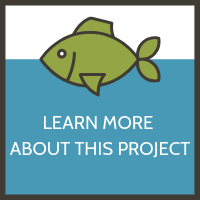
By Alaina Dismukes
The Feed the Future Innovation Lab for Fish is working with communities in the Kafue Floodplain and Lake Kariba in Zambia to understand the distribution and impact of invasive crayfish.
“This is an exciting and unique project, investigating the population ecology of crayfish in Zambia,” said Michael Rice, the project’s lead principal investigator and University of Rhode Island professor.
Within the last few years, invasive species of crayfish were brought to Zambia. One species is the Australian red claw crayfish (Cherax quadricarinatus), which can reach a size of 25 cm. The other species is the Louisiana swamp crayfish (Procambarus clarkii), also called mudbugs or crawdads.
“Both of these got loose in the Zambezi River drainage area, and there has developed a fishery for them,” Rice said. “Our project is trying to first get a handle on the distribution.”
A key question for the project currently is: Where are the crayfish within the Zambezi River and the Kafue Floodplain?
“We want to make sure the crayfish are confined to the watershed where they are found because the adjoining watershed is the famous Okavango Delta area, which is a world heritage site in terms of wildlife management,” he said. “We do not want crayfish to get in there because a lot of money is made by ecotourism, and the crayfish could disrupt the ecosystem.”
The project team is conducting trapping studies in the Zambezi River and the Kafue Floodplain to understand the population structure of the crayfish. Once the team determines the natural reproduction rate of the crayfish, the researchers can calculate what it would take to match the reproduction rate with the harvest rate.
“This way, they can be harvested as quickly as they reproduce,” Rice said. “The only effective way to control an invasive species is to basically remove it as quickly as possible from the environment.”
Another aspect of the project is educating people about the dangers of the invasive crayfish to the ecotourism industry and to critical natural areas such as the Okavango Delta wetlands.
“It is a tricky issue, but we want to take a proactive approach," he said. "When you have an invasive species like this, it disrupts the economic lives of the people in the area. It is not an ecological problem in isolation, but there are people's livelihoods involved who rely on the ecosystem the way it was before. We want to figure out ways to mitigate these concerns.”
The project team plans to share their findings and recommendations with the local fisheries and policymakers, so they can make informed decisions regarding the invasive species.
“We have more of a total sustainability idea in mind, and I think that is key in international development,” Rice said. “If we are successful in our projections, we can figure out the appropriate approach to mitigate the risks that crayfish may have on the environment.”
Read more about the “Population Ecology and Current Distribution Assessment of the Introduced Invasive Crayfish in the Kafue Floodplain and Lake Kariba, Zambia” project by clicking here.
Published September 22, 2021

